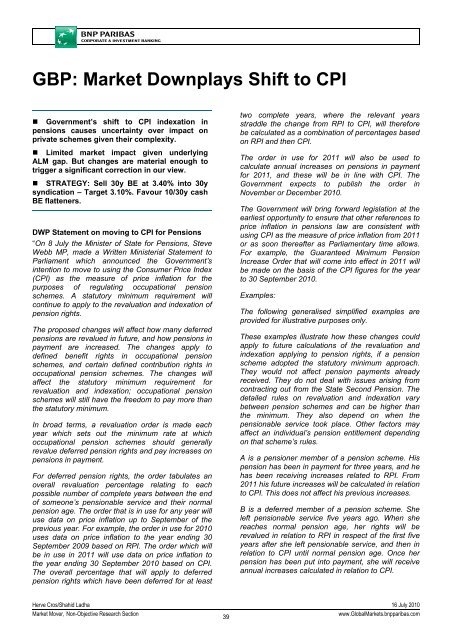Market Economics | Interest Rate Strategy - BNP PARIBAS ...
Market Economics | Interest Rate Strategy - BNP PARIBAS ...
Market Economics | Interest Rate Strategy - BNP PARIBAS ...
Create successful ePaper yourself
Turn your PDF publications into a flip-book with our unique Google optimized e-Paper software.
GBP: <strong>Market</strong> Downplays Shift to CPI<br />
• Government’s shift to CPI indexation in<br />
pensions causes uncertainty over impact on<br />
private schemes given their complexity.<br />
• Limited market impact given underlying<br />
ALM gap. But changes are material enough to<br />
trigger a significant correction in our view.<br />
• STRATEGY: Sell 30y BE at 3.40% into 30y<br />
syndication – Target 3.10%. Favour 10/30y cash<br />
BE flatteners.<br />
DWP Statement on moving to CPI for Pensions<br />
“On 8 July the Minister of State for Pensions, Steve<br />
Webb MP, made a Written Ministerial Statement to<br />
Parliament which announced the Government’s<br />
intention to move to using the Consumer Price Index<br />
(CPI) as the measure of price inflation for the<br />
purposes of regulating occupational pension<br />
schemes. A statutory minimum requirement will<br />
continue to apply to the revaluation and indexation of<br />
pension rights.<br />
The proposed changes will affect how many deferred<br />
pensions are revalued in future, and how pensions in<br />
payment are increased. The changes apply to<br />
defined benefit rights in occupational pension<br />
schemes, and certain defined contribution rights in<br />
occupational pension schemes. The changes will<br />
affect the statutory minimum requirement for<br />
revaluation and indexation; occupational pension<br />
schemes will still have the freedom to pay more than<br />
the statutory minimum.<br />
In broad terms, a revaluation order is made each<br />
year which sets out the minimum rate at which<br />
occupational pension schemes should generally<br />
revalue deferred pension rights and pay increases on<br />
pensions in payment.<br />
For deferred pension rights, the order tabulates an<br />
overall revaluation percentage relating to each<br />
possible number of complete years between the end<br />
of someone’s pensionable service and their normal<br />
pension age. The order that is in use for any year will<br />
use data on price inflation up to September of the<br />
previous year. For example, the order in use for 2010<br />
uses data on price inflation to the year ending 30<br />
September 2009 based on RPI. The order which will<br />
be in use in 2011 will use data on price inflation to<br />
the year ending 30 September 2010 based on CPI.<br />
The overall percentage that will apply to deferred<br />
pension rights which have been deferred for at least<br />
two complete years, where the relevant years<br />
straddle the change from RPI to CPI, will therefore<br />
be calculated as a combination of percentages based<br />
on RPI and then CPI.<br />
The order in use for 2011 will also be used to<br />
calculate annual increases on pensions in payment<br />
for 2011, and these will be in line with CPI. The<br />
Government expects to publish the order in<br />
November or December 2010.<br />
The Government will bring forward legislation at the<br />
earliest opportunity to ensure that other references to<br />
price inflation in pensions law are consistent with<br />
using CPI as the measure of price inflation from 2011<br />
or as soon thereafter as Parliamentary time allows.<br />
For example, the Guaranteed Minimum Pension<br />
Increase Order that will come into effect in 2011 will<br />
be made on the basis of the CPI figures for the year<br />
to 30 September 2010.<br />
Examples:<br />
The following generalised simplified examples are<br />
provided for illustrative purposes only.<br />
These examples illustrate how these changes could<br />
apply to future calculations of the revaluation and<br />
indexation applying to pension rights, if a pension<br />
scheme adopted the statutory minimum approach.<br />
They would not affect pension payments already<br />
received. They do not deal with issues arising from<br />
contracting out from the State Second Pension. The<br />
detailed rules on revaluation and indexation vary<br />
between pension schemes and can be higher than<br />
the minimum. They also depend on when the<br />
pensionable service took place. Other factors may<br />
affect an individual’s pension entitlement depending<br />
on that scheme’s rules.<br />
A is a pensioner member of a pension scheme. His<br />
pension has been in payment for three years, and he<br />
has been receiving increases related to RPI. From<br />
2011 his future increases will be calculated in relation<br />
to CPI. This does not affect his previous increases.<br />
B is a deferred member of a pension scheme. She<br />
left pensionable service five years ago. When she<br />
reaches normal pension age, her rights will be<br />
revalued in relation to RPI in respect of the first five<br />
years after she left pensionable service, and then in<br />
relation to CPI until normal pension age. Once her<br />
pension has been put into payment, she will receive<br />
annual increases calculated in relation to CPI.<br />
Herve Cros/Shahid Ladha 16 July 2010<br />
<strong>Market</strong> Mover, Non-Objective Research Section<br />
39<br />
www.Global<strong>Market</strong>s.bnpparibas.com
















